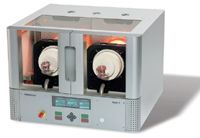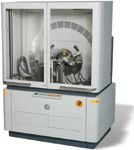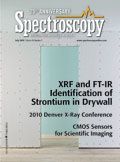2010 Pittcon Product Review: Addendum
Each year, the Pittcon Product Review presents many unique challenges. As the largest editorial project of the year, many hours go into ensuring that the review is as comprehensive as possible and that no stone is left unturned. Unfortunately, however, it does occasionally happen that a new product is missed, listed incorrectly, or otherwise presented erroneously. The products and companies listed here fall into one or more of these categories and it is our hope that this Addendum will present readers with a more complete picture of the spectroscopic products available at Pittcon 2010.
Each year, the Pittcon Product Review presents many unique challenges. As the largest editorial project of the year, many hours go into ensuring that the review is as comprehensive as possible and that no stone is left unturned. Unfortunately, however, it does occasionally happen that a new product is missed, listed incorrectly, or otherwise presented erroneously. The products and companies listed here fall into one or more of these categories and it is our hope that this Addendum will present readers with a more complete picture of the spectroscopic products available at Pittcon 2010.
PANalytical
Product Name: SST-mAX50 XRF Tube
Used for: Laboratory conditions.

SST-mAX50 XRF Tube
Accessory/Component: End window X-ray tube for WD-XRF
Suggested Applications: All XRF process control applications desiring excellent light element performance, long-term accuracy and reliability of measurements, and minimal recalibration effort.
Primary Benefits: High-performance WD-XRF X-ray tube with thin window technology offering excellent sensitivity for light elements that is sustained throughout the lifetime of the tube.
Unique Features: 50 µm Be window for enhanced light element performance, CHI-BLUE coating for excellent corrosion resistance and durability of the thin window, and ZETA technology for like new performance (no drift) over the life of the tube.
Product Name: Axios WD-XRF System
Used for: Laboratory conditions.
Suggested Applications: All XRF laboratory and process control applications for which cost effectiveness is essential, but accuracy, repeatability, and system uptime remain critical parameters.
Primary Benefits: Low-power, high-performance WDXRF system that offers economical yet robust XRF analysis, no chiller required, with rugged reliability and accuracy. 21CFR11 and cGMP compliant.
Product Name: CubiX3 X-ray Diffraction System
Used for: Laboratory conditions.
Suggested Applications: Process control for clinker and cement production; aluminum bath control; mining and mineral analysis; pharmaceutical raw materials to finished product; and environmental applications such as respirable silica analysis and asbestos.
Special features: Portability, equation transfer, battery powered; high-speed linear detector PIXcel, which was codeveloped with CERN; sample changer can be configured for different size automation rings; five different anode materials available. 21CFR11 and cGMP compliant.
Primary Benefits: CubiX3 is the fastest industrial XRD on the market, now with more automation flexibility. The CubiX3 supports the full analytical X-ray powder analysis methodology from classical data analysis up to full pattern cluster analysis for statistical data interpretation and pass/fail determination.
Unique Features: PIXcel detector is up to 150X faster than conventional detectors, pneumatic loading and theta-theta goniometer contribute to the fastest sample throughput; CubiX3 can be configured as a walk-up XRD, requiring no knowledge of XRD to introduce sample without disrupting batch in progress and with no user input receive report of analysis by e-mail or to LIMS.
Product Name: Eagon 2 Fusion System
Used for: Laboratory conditions; sample prep for X-ray.

Eagon 2 Fusion System
Suggested Applications: Rocks and ore, cement, clinker or slag.
Primary Benefits: Push-button operation; stores many recipes; fully safe operation; no application knowledge required for the operator.
Unique Features: Ultimate safety; cold to cold operation.
Other Special Features: Portability, equation transfer, battery powered; Simultaneous production of two beads; fully automated operation; electric furnace; requires no gas supplies, cooling water or compressed air; can be used in other equipment and compatible with other manufacturers' equipment.
Product Name: Empyrean X-ray Diffraction System
Used for: Laboratory conditions; X-ray diffractometer

Empyrean X-ray Diffraction System
Suggested Applications: Phase identification, phase quantifications, crystallinity determination, texture and stress analysis, thin film analysis, SAXS, computed tomography, pair distribution function analysis, behavior under nonambient conditions
Primary Benefits: Analyzes powders, thin films, nanomaterials, and solid objects. The only diffractometer that combines diffraction with computed tomography (CT); 21CFR11 and cGMP compliant.
Unique Features: PIXcel3D- the only detector for 0D,1D, 2D, and 3D applications, widest range of samples, highest performance goniometer.

LIBS Illuminates the Hidden Health Risks of Indoor Welding and Soldering
April 23rd 2025A new dual-spectroscopy approach reveals real-time pollution threats in indoor workspaces. Chinese researchers have pioneered the use of laser-induced breakdown spectroscopy (LIBS) and aerosol mass spectrometry to uncover and monitor harmful heavy metal and dust emissions from soldering and welding in real-time. These complementary tools offer a fast, accurate means to evaluate air quality threats in industrial and indoor environments—where people spend most of their time.
NIR Spectroscopy Explored as Sustainable Approach to Detecting Bovine Mastitis
April 23rd 2025A new study published in Applied Food Research demonstrates that near-infrared spectroscopy (NIRS) can effectively detect subclinical bovine mastitis in milk, offering a fast, non-invasive method to guide targeted antibiotic treatment and support sustainable dairy practices.